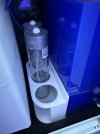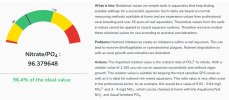ICP Testing (Part 2)
I am currently on a monthly cadence to perform ICP tests until they are more or less dialed in, after which I will do them quarterly, and then hopefully do not need to do them more than 3 times a year.
After using Triton for a while, I have been using the Fauna Marin Reef ICP Total tests, which I purchase here:
https://icp1999.com/product/reef-icp-test-total-set-of-3/. The tests cost 40 USD plus 7 USD shipping and it takes approx 7-8 actual days until they arrive at CoralVue in Louisina.
My approach assumes there is value in doing ICP testing, so the below thoughts are based on this assumption, and I recognize there are other opinions, and maybe I realize later that doing this was huge waste of money and time. For now, I strongly believe there is power in doing them, understanding and acting on the results.
After receiving the ICP results from Fauna Marin, I have been sending them to Chris Woods from Captiv8 who will send me back an analysis with the required dosing to get them to 'seawater' parameters, which might deviate from what Fauna Marin proposed target parameters. See attached Excel.
After receiving his feedback, there are two options: a) using their instructions and preparing your own custom solution very cheap, or b) asking them to prepare a 30 day / 1000 ml custom solution for you, which will cost 24 USD plus 12 USD shipping approx. I have done the latter twice, but will prepare my own solution next time for a fraction of the cost.
I am dosing the custom solution with an Ecotech Versa pump, an Octoaquatics bottle holder, and a 850 ml Voss bottle (picture). Now interestingly, I was not aware that the solution should not be exposed to strong light, according to Chris. Since I have a refugium with a 12 hour light schedule, I will start now wrapping the bottle in alumnium (could not find a sleeve that fits the bottle).

Another thing I am changing now is to not use activated carbon while I am dosing traces, in response to Chris's feedback on the use this:
Because trace elements, in particular cations, readily combine with latent organic material, that which is in the dissolved form will be removed from the system by activated carbon (as well as by protein skimming), making that material a passive means of trace cation export. The impact on most trace anions (other than iodine species) is less owing to their relatively low interaction with latent DOM and POM, however several trace ions critical to photosynthesis and related biochemical processes are cations (e.g. Fe, Mn, Co, Ni, Cu, Zn), so depleted values of those ions may be anticipated when activated carbon is employed.
Approx two weeks before the end of the bottle, I will submit another ICP test for further adjustments.
Feb 26 ICP sample
My latest results are included in the pdf attached. There is a more detailed analysis and recommendations and the pdf is only meant to show high level the outcome, but the value lies in their recommendations backed up by further content in their knowledge data base for additonal reading and deep dive into the meaning and impact of various trace elements.
They claim to be able to predict unwanted developments in your tank after 5 tests, based on their database of 100,000 + water samples collected globally, so will see when I am there. I will run the third test in a couple of weeks only.
Key outcomes:
- Salinity is now back in line with target after changing the Milwaukee from PPT to PSU and aim for 35 PSU.
- Alkalinity target is relatively low compared to what I had in mind. But this recommendation aligns with Captiv8 recommendation so I am going to aim for 7.3 going forward. Also, Hanna is the second time now testing 0.6 above what the ICP tested, so it seems I can 'rely' on this inaccuracy going forward, i.e., Hanna Alk of 8 is actual Alk of 7.4.
- Nitrate and Phosphate are almost exactly how I measured them, with only a 0.1/0.2 difference for Nitrate and 0.01 for Phosphate.
- Many values were actually pretty well aligned at the time, but several important ones needed attention. I am hoping that getting them in line will help with the Dino battle more holistically. Overall, they are still not where they should be an this results differs quite a bit from the last result where I only dosed Isol8 MT from Captiv8, an all in one product they offer.
- Aluminum decreased from the last test and I have taken further actions which will hopefully further reduce this to an acceptable level. Also, I am working on changing my lid, as this seems to be the root cause (?).





